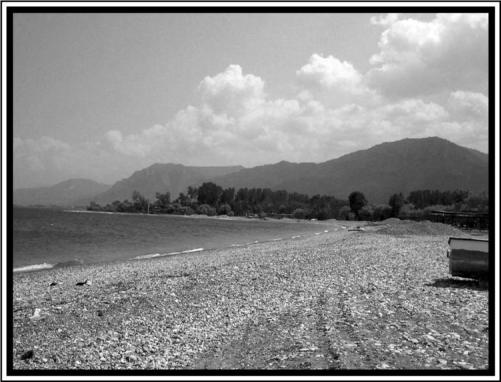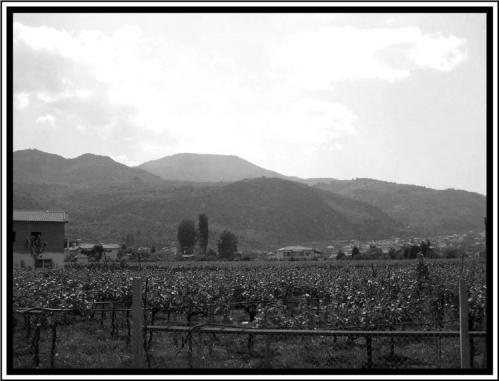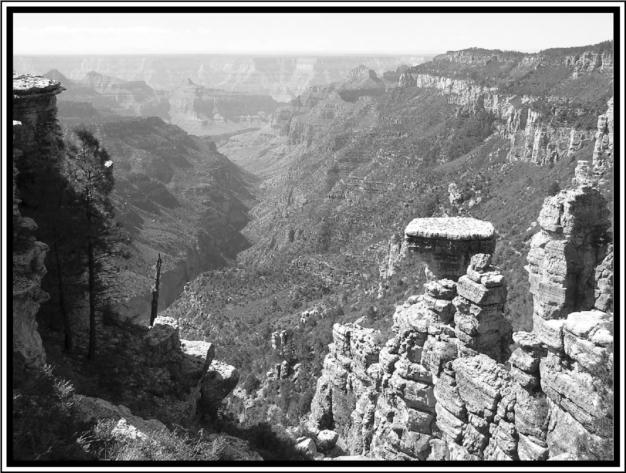Hidden History: Lost Civilizations, Secret Knowledge, and Ancient Mysteries (16 page)
Read Hidden History: Lost Civilizations, Secret Knowledge, and Ancient Mysteries Online
Authors: Brian Haughton
Tags: #Fringe Science, #Gnostic Dementia, #U.S.A., #Alternative History, #Amazon.com, #Retail, #Archaeology, #History

But all this was to change one terrible night in the winter of 373 B.C. For
a period of five days, citizens of the city
gazed in bewilderment as snakes,
mice, martens, and other creatures
fled from the coast and made for higher
ground. Then, on the fifth night, "immense columns of flame" (now known
as earthquake lights) were witnessed
in the sky, followed by a massive earthquake, and a towering 32 foot high tsunami wave. The coastal plain was
submerged, and as Helike collapsed,
the tsunami rushed in and dragged its
buildings and its inhabitants out with
the retreating waters. The city and its
surroundings disappeared beneath
the sea, along with 10 Spartan ships
that had been ancored in the harbor.
The neighboring city of Boura, and the
Temple of Apollo at Delphi, were also
destroyed.
When a rescue party arrived the
next morning, nothing remained of the
once great city but the tops of the trees
in Poseidon's sacred grove, peeping
above the waves. Perhaps because
Helike had been a revered center for
worship of Poseidon (the god of earthquakes and the sea), a tradition originated among its jealous neighbors that
the city's destruction was punishment
sent by the angry god for desecrating
his sanctuary. Following the disaster,
the former territory of Helike was
doled out between its neighbors, with
the city of Aegio taking over leadership of the Achaean League. Hundreds
of years later a Roman city was built
on the site, which also appears to have
been partly destroyed by an earthquake in the fifth century A.D. For centuries after the disaster ancient
writers such as Pliny, Ovid, and
Pausanias reported that the submerged
ruins of Helike could be glimpsed on
the sea floor. The Greek scientific
writer, astronomer, and poet, Eratosthenes (276-194 B.C.) visited the site
and recorded reports by local ferrymen
of an upright bronze statue of Poseidon
submerged in an inland lagoon, where
it often trapped the nets of fishermen.
But soon afterwards the area silted
over and the location became lost.
In 1861, German archaeologists visiting the region obtained a bronze coin
of Helike featuring a splendid head of
Poseidon, but nothing else surfaced
from the ancient site. Ancient writers
had all stated that the remains of the
city lay submerged beneath the
Corinthian Gulf, but for decades numerous expeditions searched for it
without success. In 1988 the Helike
Project was formed to locate the lost
city, but a 1988 sonar survey under
their auspices revealed no trace beneath the sea. Consequently, director
of the Helike Project, archaeologist
Dora Katsonopoulou, and Dr. Steven
Soter, of the American Museum of
Natural History, decided to investigate the coastal plain. In 2001, a few
feet beneath the mud and gravel, the
team discovered ruins of Classical
buildings, which turned out to be the
remains of the city of Helike destroyed by the earthquake of 373 B.C.
The location of the ruins lay almost
half a mile inland, which explains why
no one had found them beneath the
sea. Analyses of the microscopic organisms preserved in the layer of fine
dark clay covering the buildings revealed that the site had been drowned
by a shallow inland lagoon, which had
subsequently silted up. The discovery
of sea shells and the possible remains
of seaweed on the site are evidence that Helike's ruins were probably at
one time beneath the sea.

© Dr. A. Siokou
The Helike Delta and the Gulf of Corinth.
The remains of one Classical building graphically illustrated the fate of
the city. One of its walls had collapsed
in a seaward direction, clear evidence
to support destruction by the backwash
of a giant wave. Amongst finds of demolished walls, pottery fragments, and
terracotta idols, the excavators found
a mint silver coin with a representation of Apollo wearing a laurel wreath,
cast in the neighboring town of Sikyon
a few decades before the earthquake
struck. The sad fate of this once great
Classical city is thought by many to
have been the inspiration for the legend of Atlantis, first recorded by Athenian philosopher Plato a few years
after the Helike earthquake, in 360 B.C.
A BBC Horizon documentary Helike-
The Real Atlantis, made in 2002, makes
this claim for the site.
The area around ancient Helike is
one of the most seismically active in
Europe, and at least 4,000 years of
ancient settlements on the site have
flourished and been destroyed by
earthquakes. So it is hardly surprising that the ancient city was the center of a cult dedicated to Poseidon, the
god of earthquakes. In August 1817, an
earthquake preceded by a sudden explosion destroyed five villages in the
place where Helike once stood. In 1861,
8 miles of coastline sunk about 6 feet,
and a 597 foot wide coastal belt of coast
was submerged beneath the waves. In
June 1995, while the Helike Project
team were working in the area, an
earthquake of 6.2 on the Richter scale
struck, killing 10 people in the adjacent town of Aigion, and demolishing
a hotel in modern Eliki, killing 16.
Dr. Steven Soter collected many
descriptions of odd events preceding
this quake, which have overtones of
the ancient accounts of the earthquake
that destroyed Helike. People heard
fierce winds when the air was still
outside, dogs howled unaccountably,
there were subterranean explosions, strange lights in the sky, and fireballs. Huge numbers of octopuses
were seen by local fishermen and, the
night before the earthquake, numerous dead mice were found on the road,
all of which had been run over by cars
while trying to make their escape into
the mountains. These incidents are
reminiscent of the behavior of animals
in the 2004 tsunami that struck Sri
Lanka, southern India, and Thailand,
caused by a huge 9.15 Richter earthquake in the Indian Ocean. In Sri
Lanka, where tens of thousands of
people lost their lives, animals appear
to have fled inland before the tsunami
struck. Even though the tsunami
caused a heavy loss of human life in the
area of Yala National Park, Sri Lanka's
biggest wildlife reserve, no dead animals were found. Experts believe that
animals possess a sixth sense with
which they sense a natural disaster.
This is certainly suggested by their behavior before the Helike earthquakes.

© Dr. A. Siokou
The plain of Helike, looking towards the mountains.
One of the most significant finds
from the Helike excavations was of
paving stones from what was probably
a Classical road. The archaeologists
from the Helike Project now hope that
following this road will lead them
nearer to the heart of the ancient site.
However, in terms of finding more complete remains of the Classical city,
there is the important question of
whether such an immensely destructive tsunami would have left anything
behind for the archaeologists to find.
Nevertheless, the team from the
Helike Project are confident that a
major part of the city will still be located. Someone who would certainly
have supported this belief was the late
Spyridon Marinatos, discoverer of the
prehistoric town of Akrotiri on the
Greek island of Santorini. One of the
earliest modern searchers for the lost
city, Marinatos once speculated that
hoards of bronze and marble Classical
sculptures could lay entombed in the
ruins of the city, and fully expected the discovery of an ancient town surpassing even the archaeological riches of
Pompeii.
Apart from the constant danger of
further earthquakes in the area, the
Helike Project now faces a further
threat to the site. In Roman times, a
road running from Corinth to the city
of Patras passed through Helike.
Traces of this road have been found
in excavations. Recently, the Greek
National Railway began laying a new
rail line which will connect Athens
with Patras. Trains are currently operating on this railway as far as
Corinth, and the line is expected to
reach Patras by 2010. At the moment,
the route of this rail line is scheduled
to run right through the center of the
ancient site, probably in the next two
or three years. Thus, the remains of
ancient Helike will be destroyed before excavations have had the chance
to uncover what would surely be priceless evidence of life in prehistoric and
Classical Greece.
In order to help protect this important archaeological site from destruction by the railway, the World
Monuments Fund has included Helike
in its List of 100 Most Endangered
Sites. But land along the coast in the
region where the Project plans to excavate is being developed quickly, and
Dora Katsonopoulou has appealed to
the Greek Ministry of Culture to make
the area an archaeological zone where
new construction is forbidden. Unfortunately, at present, the Greek
Archaeological Service and the Greek
Ministry of Culture have not acknowledged the importance of the site.
Hopefully, the significance of the
excavations will be realized before
it's too late, and the lost city of Helike
will not become lost forever.


Photograph by Scott Catron (GNU Free Documentation License).
View of Grand Canyon from Tiyo Point, North Rim.
On April 5th, 1909, an anonymous
front-page story appeared in the Phoenix newspaper the Arizona Gazette,
with the title "Explorations in the
Grand Canyon." The article described
a Smithsonian Institute-funded
archaeological expedition "under the
direction of Prof. S. A. Jordan" accompanied by an explorer in the service
of the Smithsonian named G.E.
Kinkaid. The Gazette claimed that the
team had found a vast underground
citadel within the Grand Canyon
which was "not only the oldest
archaeological discovery in the United
States, but one of the most valuable
in the world."
Kinkaid's narration of the discovery in the Gazette described how he
made the discovery while traveling
alone in a wooden boat down the
Colorado River from Green River,
Wyoming, to Yuma, looking for minerals. According to the article, about 42
miles up from the El Tovar Crystal
canyon, (probably around Marble Canyon, in the area of the present-day
Navajo Indian reservation), Kinkaid
noticed "stains in the sedimentary formation about 2,000 feet above the river bed." He then, with great difficulty,
made his way up the canyon wall to
arrive at a small cave opening, which
had steps leading down from it.
Kinkaid then passed through the entrance, and at a cross chamber 100 feet
from the entrance, he found a carved
image of a cross-legged idol, which he
thought resembled Buddha and was
probably of Tibetan origin. Several
hundred feet along the 12 foot wide
passageway he discovered a crypt containing mummies, one of which he
stood up and photographed by flashlight. There were numerous side passages, rooms, and various artifacts,
including copper tools, urns, and cups
of copper and gold, enamelled and
glazed pottery vessels, engraved yellow stones strewn all over the floors,
and an unknown grey metal resembling platinum. He also found hieroglyphics, which he believed were of an
"Egyptian or Oriental type."
